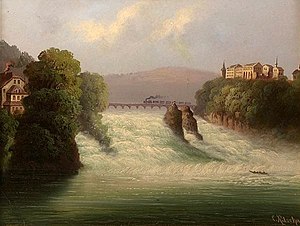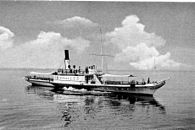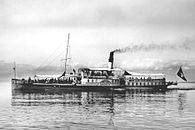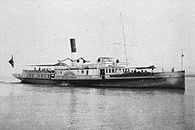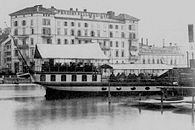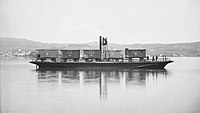Swiss Northeast Railway
| Swiss Northeast Railway | |
|---|---|
| legal form | Corporation |
| founding | July 1, 1853 |
| resolution | January 1, 1902 |
| Reason for dissolution | nationalized in the SBB risen |
| Seat | Seebach near Zurich |
| management | Alfred Escher |
| Branch | Rail and ship traffic |
|
Iron Thur Bridge built in 1856/57 on the
line from Winterthur to Schaffhausen opened on April 15, 1857 (1857) | |||||||||||||||||||||||||||||||||||||||||||||||
| Swiss Northeast Railway 1871–1874 | |||||||||||||||||||||||||||||||||||||||||||||||
|---|---|---|---|---|---|---|---|---|---|---|---|---|---|---|---|---|---|---|---|---|---|---|---|---|---|---|---|---|---|---|---|---|---|---|---|---|---|---|---|---|---|---|---|---|---|---|---|
|
|||||||||||||||||||||||||||||||||||||||||||||||
The Swiss Northeastern Railway (NOB) was a railway company of Switzerland . She also operated shipping on Lake Constance and Lake Zurich . Until the merger of the western Swiss railways to form the Jura-Simplon-Bahn (JS) in 1890/91 it was the largest Swiss railway company.
history
Building the trunk network
The Swiss Northeast Railway was created on July 1, 1853 through the merger of the Swiss Northern Railway (SNB), better known as the " Spanish-Brötli -Bahn", and the Zurich-Lake Constance Railway . The originally planned continuation of the northern line from Baden to Basel initially failed due to the different interests of the cantons of Zurich , Aargau and Basel .
The main initiator of the merger was Alfred Escher from Zurich , who previously headed the Zurich-Bodenseebahn. He advocated financing the railways through private investors instead of public funds. In order to cover the large capital requirements of the railways, he suggested the foundation of the Schweizerische Kreditanstalt .
The NOB endeavored to establish connections abroad for freight traffic. First, she was able to establish a direct connection between Zurich and Lake Constance . This made it the direct competitor of the United Swiss Railways (VSB) based in St. Gallen . Coming from Romanshorn , the NOB first opened the line to Winterthur on May 16, 1855 . The further connection Zurich – Winterthur was opened in two stages on December 27, 1855 from Winterthur to Oerlikon and on June 26, 1856 to Zurich, where there was a connection to the existing former northern line from Zurich to Baden. Thanks to the NOB, the tranquil village of Romanshorn grew into one of the most important transport hubs in Eastern Switzerland. In 1855, the NOB started shipping on Lake Constance. In 1869 the ferry service between Romanshorn and Friedrichshafen ( Germany ) was established. The expansion already led to the expansion of the railway systems under the NOB and to the construction of the largest port of Lake Constance - in terms of area - for which the bank on Lake Constance had to be specially filled.
In 1856, the NOB completed the Winterthur – Schaffhausen railway , which was started by the Rheinfallbahn and which went into operation on April 16, 1857. The former northern railway line between Zurich and Baden was extended to the west. From the Baden – Aarau railway line , the section from Baden to Brugg with the bridge over the Reuss was opened on September 29, 1856 . The rest of the connection to Aarau followed on May 15, 1858 , where the NOB network met that of the Swiss Central Railway (SCB) in Wöschnau on the Aarau - Solothurn canton border and Zurich was connected to Basel.
On August 18, 1859, the NOB was able to establish a direct connection with other countries with the opening of the Turgi – Waldshut line. This created the main network of the Northeast Railway. The most important northern gateway to Switzerland, namely Basel, was secured by the SCB. Freight traffic was and remained the most important business area of the NOB, which initially enjoyed a good return.
The NOB was involved in other railway companies. After the Swiss Ostwestbahn (OWB) with a connection from La Neuveville via Bern - Lucerne to Zurich failed, the NOB founded the Zurich-Zug-Lucerne Railway (ZZL) together with the cantons of Zurich, Zug and Lucerne in 1861 and built the section finished by June 1, 1864.
Like other railway companies at the time, the NOB aimed to maximize profits for the private bankers in the short term . These took a seat in the management and on the board of directors to secure their profits. The rights of the other shareholders were canceled by means of ordinary shares . By exerting political influence, they ensured tax exemptions and subsidies . Alfred Escher was not only Chairman of the Board of Directors of the NOB and Chairman of the Board of Directors of the Kreditanstalt , but also a Zurich Government Councilor and National Councilor for 34 years . The maintenance was neglected and the substance of the railway company eroded. The first symptoms of the crisis appeared as early as 1857, and worsened in 1867.
Railroad crisis
The behavior of the Zurich railway barons meant that from 1872 the Swiss National Railway (SNB) attempted to compete with the existing railway companies with a second railway connection between Lake Geneva and Lake Constance. As a defense measure, the NOB and SCB expanded the existing network between 1873 and 1882. The two companies founded the Aargauische Südbahn and the Bözbergbahn in equal shares . The former built and opened between 1873 and 1882 the Rupperswil – Immensee line with the branch line from Hendschiken to Brugg, which connected the NOB and SCB network with the Gotthard Railway, which opened in 1882 . The Bözbergbahn operated by the NOB opened the Brugg – Pratteln line in 1875 , creating a direct connection from Zurich to Basel together with the existing NOB and SCB lines.
In addition, under the new president Friedrich Peyer in the courtyard , the NOB tried to eliminate competition in advance by accelerating the expansion of its own network. It secured concessions for various railway lines and entered into commitments with cantons and founding committees for the construction of these unprofitable lines. To do this, the NOB had to raise outside capital, which led to massive debts. The financial difficulties brought the NOB to the edge of the abyss. The construction of the right bank Zurich Lake Line , which had started in 1873, had to be stopped due to the financial crisis. The important left bank stretch to Ziegelbrücke was opened in 1875. For years after 1877 the NOB could no longer pay dividends . The market price of the shares collapsed from 670 francs in 1871, a 53 francs a year 1879th An investigation commissioned by the General Assembly found serious errors in corporate governance.
On March 2, 1877, the NOB asked the Federal Council to release it from the construction obligations it had entered into. On February 14, 1878, the Federal Assembly confirmed an agreement that the construction obligations were maintained, but were postponed until the financial restructuring of the NOB. The construction period for the so-called moratorium lines Thalwil – Zug , Etzwilen – Schaffhausen , Bülach – Schaffhausen , Koblenz – Stein , Dielsdorf – Niederweningen and the right bank of the Zürichseebahn has been extended. In an agreement with the Canton of Glarus, completion of the construction of the Glarus – Linthal route was set for May 1, 1879. The dividend payment for 1880 to 1883 was suspended. On October 25, 1887, the Federal Council instructed the NOB to start building the right bank of the Zürichseebahn. On June 27, 1888, the completion dates for the remaining moratorium lines were set.
The ruinous rival project of the national railway ended in bankruptcy . The cities and municipalities involved suffered from the debt for decades. On October 1, 1880, the NOB took over the route network of its rival for a fraction of the construction costs. The Zofingen – Suhr section was resold to SCB.
Recovery and nationalization


After 1880, the NOB's situation slowly improved. The increase in traffic led to the expansion of the stations and the procurement of additional rolling stock. After Alfred Escher's death in 1882, Adolf Guyer-Zeller headed the NOB.
The railroad crisis had caused many local shareholders to sell their papers to major foreign shareholders. The railroad stocks played a major role in speculation on the stock market . A finance group headed by Adolf Guyer was able to secure the majority of votes at the general assembly , voted out the management and replaced it with docile people.
The vast majority of the shares were in foreign hands, and the majority of the bonds were owned by Swiss owners. The interest rate for solid Swiss railway bonds was 4% at the time. In order to increase the return on the shares, bonds were converted into bonds with an interest rate of 3½%. This reduced the company's interest burden and increased profits.
On January 8, 1885 train went Winterthur - Zurich after passing a closed signal to a from Wettingen on coming train. The train from Wettingen was pushed backwards from the Seebach station over the junction on the open road , in order to continue forwards in the direction of Zurich. The accident resulted in seven injuries and major property damage. On May 30, 1898, a NOB passenger train ran over a group of Centralbahn employees at the southern exit of the Gütschtunnel near Lucerne who had been busy with track work. Seven railway workers were killed instantly and four seriously injured. On June 4, 1899, during the Aarau railway accident, the NOB's Zurich – Geneva night express train passed the designated stopping point and hit two stationary locomotives on the Central Railway. The accident left two dead and three seriously injured.
The railway workers' demands for work regulations and wages, which the other private railways complied with in 1896, met with resistance from the profit-oriented NOB. So it came to the labor dispute of the NOB staff in 1897. In Zurich, masses of travelers signed up in the complaint book. At times the milk was running out. The 5000 employees were able to enforce their demands after a 41-hour strike. The labor dispute at the NOB contributed to the adoption of the referendum of 1898, with which the nationalization of the largest private railways was decided.
On January 1, 1902, the NOB with a route network of 853 km and the Swiss Lake Constance fleet became the property of the Swiss Federal Railways (SBB).
Shipping companies
Shipping represented the natural continuation of the railway lines that ended at the lakes. The onward transport of travelers was possible without any difficulties. Goods transport, on the other hand, was much more complicated and expensive because the goods had to be reloaded twice.
Lake Constance
Lake Constance was the most important trade route for traffic between Switzerland and Germany. The Rhine only became navigable as far as Basel in 1904. In 1855, the NOB began shipping traffic on Lake Constance with the smooth-deck steamers "Thurgau" and " Stadt Zürich " . On January 1, 1857, the NOB merged with the Schweizerische Dampfboot-Aktiengesellschaft for the Rhine and Lake Constance . It was founded in Schaffhausen in 1850 as a cantonal company and in the following four years it put the steam ships “Stadt Schaffhausen”, “Rhein”, “Stadt St. Gallen” and “Bodan” into operation. In 1863, ship operations on the Rhine were stopped and the four steamers moved to Romanshorn.
On March 11, 1861, the steamer "Stadt Zürich" rammed and sank the Bavarian steamer " Ludwig " in a storm . Three people survived, 13 were killed. On February 12, 1864, the Bavarian steamer " Jura " was also rammed and sunk by the "City of Zurich".
In order to avoid reloading the goods, the Bavarian and Württemberg steamship administration decided in 1867, together with the NOB, to transport railway wagons with trajectory ships . A steam ferry " Dampftrajekt I " was used on the Friedrichshafen – Romanshorn route. This ferry, over 70 meters long, could accommodate 18 freight wagons, but consumed horrendous coal. It was retired and canceled in 1882. A second ferry “ Dampftrajekt II ” began operating in 1874 between Lindau and Romanshorn.
In 1884 the smooth-deck steamer "Stadt Zürich" was converted into a half saloon steamer "Zürich". In 1887 the NOB put the newly built saloon steamer “Helvetia III” into service, which caused a sensation with its clipper bow and bowsprit . In 1892 the half saloon steamer "Säntis" replaced the "City of Schaffhausen". In 1897 the half saloon steamer “St. Gotthard ”, which replaced the smooth deck ship“ Stadt St. Gallen ”.
In 1902, with the nationalization of the NOB, the entire shipping operations were transferred to the Swiss Federal Railways (SBB).
Lake Zurich
In 1864 the steam boat company left bank was established with its headquarters in Horgen . In 1868 it merged with the older Zürichsee-Walensee-Gesellschaft AG to form the steamboat company for Lake Zürich . Shortly before the start of the Zurichseebahn on the left bank , the NOB took over the entire fleet in 1875. The NOB immediately severely restricted traffic, so that competing companies formed. When the Zurich – Meilen – Rapperswil railway started operating in 1894, the number of ships on the six ships “ Helvetia ”, “Concordia”, “Lukmanier” and “St. Gotthard ”,“ Taube ”and“ Schwalbe ”decreased.
When the NOB was nationalized in 1903, ship operations were outsourced. The entire public shipping traffic was brought together in the Zürcher Dampfboot-Aktiengesellschaft (ZDG) in 1902 . The wheel and screw steamers taken over by the NOB were replaced by more modern ships, with the exception of the “Helvetia”.
The ferry traffic on Lake Zurich lasted only a short time. In 1885 the NOB created a nameless one from Escher, Wyss & Cie. built trajectory put into operation. The traffic from the Wollishofen transshipment port on the left bank to the Uetikon on the right bank served almost exclusively the local chemical factory . With the opening of the right bank of the Zürichseebahn in autumn 1894, traffic was stopped.
" Helvetia " put into service in 1875
Route network
| Swiss Northeast Railway and Bözberg Railway 1897–1901 | ||||||||||||||||||||||||||||||||||||||||||||||||||||||||||||||||||||||||||||||||||||||||||||||||||||||||||||||||||||||||||||||||||||||||||||||||||||||||||||||||||||||||||||||||||||||||||||||||||
|---|---|---|---|---|---|---|---|---|---|---|---|---|---|---|---|---|---|---|---|---|---|---|---|---|---|---|---|---|---|---|---|---|---|---|---|---|---|---|---|---|---|---|---|---|---|---|---|---|---|---|---|---|---|---|---|---|---|---|---|---|---|---|---|---|---|---|---|---|---|---|---|---|---|---|---|---|---|---|---|---|---|---|---|---|---|---|---|---|---|---|---|---|---|---|---|---|---|---|---|---|---|---|---|---|---|---|---|---|---|---|---|---|---|---|---|---|---|---|---|---|---|---|---|---|---|---|---|---|---|---|---|---|---|---|---|---|---|---|---|---|---|---|---|---|---|---|---|---|---|---|---|---|---|---|---|---|---|---|---|---|---|---|---|---|---|---|---|---|---|---|---|---|---|---|---|---|---|---|---|---|---|---|---|---|---|---|---|---|---|---|---|---|---|---|
|
||||||||||||||||||||||||||||||||||||||||||||||||||||||||||||||||||||||||||||||||||||||||||||||||||||||||||||||||||||||||||||||||||||||||||||||||||||||||||||||||||||||||||||||||||||||||||||||||||
| No. | Railway line | Route section | opening | Double track | comment | length |
|---|---|---|---|---|---|---|
| 1. | Zurich – Turgi –Aarau –Wöschnau | Zurich - Baden | Aug 9, 1847 | 1861 | Built by the Swiss Northern Railway (SNB), taken over on July 1, 1853 | 49.551 km |
| Baden - Turgi | Sept 29, 1856 | |||||
| Turgi - Brugg | 1862 | |||||
| Brugg– Aarau | May 15, 1858 | |||||
| Aarau– Wöschnau | July 16, 1872 | in Wöschnau connection to the Centralbahn (SCB) | ||||
| 2. | Zurich – Winterthur – Romanshorn | Zurich– Oerlikon | June 26, 1856 | May 30, 1860 | planned by Zurich-Bodenseebahn , taken over on July 1, 1853 | 82.538 km |
| Oerlikon– Wallisellen | Dec. 27, 1855 | |||||
| Wallisellen– Effretikon | 1861 | |||||
| Effretikon– Winterthur | 1862 | |||||
| Winterthur– Romanshorn | May 16, 1855 | - | ||||
| 3. | Sea line | Romanshorn– Rorschach | Oct 15, 1869 | - | Rorschach Hafen – Rorschach: parallel track to the United Swiss Railways (VSB) | 33.292 km |
| Romanshorn – Kreuzlingen – state border (- Constance ) | July 1, 1871 | |||||
| 4th | Rhine Falls Railway Winterthur - Neuhausen - Schaffhausen | April 16, 1857 | - | planned by Rheinfallbahn, taken over on Nov. 4, 1856 | 30.380 km | |
| 5. | Turgi – Koblenz – state border (- Waldshut ) | Aug 18, 1859 | - | from the middle of the Rhine bridge property of the Baden State Railways (BadStB) | 15.509 km | |
| 6th | Left bank Zürichseebahn Zürich– Ziegelbrücke | Zurich– Wiedikon | Sept 20, 1875 | May 27, 1897 | 55.824 km | |
| Wiedikon– Thalwil | June 1, 1896 | |||||
| Thalwil - brick bridge | - | |||||
| 7th | Brick Bridge – Linthal | Brick Bridge - Näfels | - | Näfels – Glarus route owned by VSB, shared by NOB | 19.688 km | |
| Glarus - Linthal | June 1, 1879 | |||||
| 8th. | Winterthur – Bülach – Eglisau – Koblenz | Winterthur - Bülach | Aug 1, 1876 | - | 47.170 km | |
| Bülach– Eglisau | June 1, 1897 | Part of the Zurich – Bülach – Schaffhausen route | ||||
| Eglisau– Koblenz | - | |||||
| 9. | (Zurich-) Oerlikon – Oberglatt – Bülach | May 1, 1865 | - | built by Bülach-Regensberg-Bahn (BR), taken over on Jan. 1, 1877 | 15.945 km | |
| 10. | Wehntalbahn | Oberglatt - Dielsdorf | - | 10,750 km | ||
| Dielsdorf - Niederweningen | Aug 12, 1891 | |||||
| 11. | Bülach-Baden Railway Niederglatt - Otelfingen - Wettingen | Oct. 1, 1877 | - | 18.293 km | ||
| 12. | Winterthur – Etzwilen –Singen | July 17, 1875 | - | built by the Swiss National Railway (SNB), taken over on October 1, 1880 | 43.961 km | |
| 13. | Etzwilen – Emmishofen – Konstanz and Emmishofen – Kreuzlingen | - | 30.099 km | |||
| 14th | Effretikon – Kloten – Oerlikon – Seebach – Otelfingen (–Wettingen) | Oct 15, 1877 | - | built by the national railway (with parallel track Otelfingen – Wettingen to the NOB), taken over by NOB on June 1, 1880; 2. Otelfingen – Wettingen track dismantled in 1882. | 27.207 km | |
| 15th | Wettingen – Lenzburg – Suhr | Wettingen - Baden Upper Town | - | built by Nationalbahn, taken over on June 1, 1880 | 23.249 km | |
| Baden Oberstadt– Suhr | September 6, 1877 | |||||
| 16. | Suhr-Aarau | built by Nationalbahn, taken over by NOB together with SCB on June 1st, 1880 | 1.752 km | |||
| 17th | Bischofszellerbahn Sulgen - Gossau | Feb. 1, 1876 | - | built by Bischofszellerbahn (SG), taken over on August 1, 1885 | 22.670 km | |
| 18th | Effretikon – Wetzikon – Hinwil | 17 Aug 1876 | - | built by the railway company Effretikon – Pfäffikon – Hinwil (EH), taken over on January 1, 1886 | 22.157 km | |
| 19th | Zurich Altstetten – Kollermühle – Zug and Kollermühle – Underground (–Luzern) | June 1, 1864 | - | built by the Zurich-Zug-Luzern-Bahn (ZZL), taken over on January 1, 1892 | 62.550 km | |
| 20th | Right bank Zürichseebahn Zürich– Rapperswil | Stadelhofen- Rapperswil | March 15, 1894 | - | 34.359 km | |
| Zurich – Stadelhofen | Oct. 1, 1894 | |||||
| 21st | Etzwilen – Schaffhausen | Etzwilen– Feuerthalen | Nov 1, 1894 | - | 16.248 km | |
| Feuerthalen – Schaffhausen | April 2, 1895 | |||||
| 22nd | (Bülach-) Eglisau – Neuhausen (-Schaffhausen) | June 1, 1897 | - | between Rafz and Neuhausen over German territory | 16.248 km | |
| 23. | Thalwil – Zug | June 1, 1897 | - | The continuation Zug– Arth-Goldau , which opened at the same time, belonged to the Gotthard Railway (GB). | 17.049 km | |
| Total (1901) | 94.202 km (14%) | 697.453 km | ||||
| Lines operated jointly with other railways: | ||||||
| 1. | Bözbergbahn (BöB) | Pratteln - Stein-Säckingen | Aug 2, 1875 | March 24, 1895 | NOB and SCB (operated by the NOB) | 47.970 km |
| Stein-Säckingen-Brugg | - | |||||
| Stein-Säckingen-Koblenz | Aug 1, 1892 | 25.501 km | ||||
| Total (190) | 21.40 km (29%) | 73.471 km | ||||
| 2. | Aargauische Südbahn (ASB) Rupperswil - Hendschiken - Wohlen - Immensee and Brugg –Hendschiken | 1874 to 1882 | - | NOB and SCB (operated by the SCB) | 57.472 km | |
| 3. | Wohlen-Bremgarten Railway (WB) | Sept. 1, 1876 | - | NOB, SCB and Bremgarten municipality (operated by SCB) | 6.620 km | |
Acquired courses
| Railway company | Route section | opening | length | comment | Participation of the NOB | takeover |
|---|---|---|---|---|---|---|
| Swiss Northern Railway (SNB) | Zurich – Baden railway line | August 9, 1847 | 22.53 km | - | July 1, 1853 | |
| Zurich-Bodenseebahn (ZBB) | Zurich – Winterthur – Romanshorn | (May 18, 1855) | 82.54 km | Takeover before start-up | - | July 1, 1853 |
| Rhine Falls Railway | Winterthur – Schaffhausen | (April 16, 1857) | 30.38 km | Takeover before start-up | - | November 4, 1856 |
| Bülach-Regensberg Railway (BR) | Oerlikon – Oberglatt – Bülach / Dielsdorf | May 1, 1865 | 20.30 km | Operation by NOB | CHF 0.6 million bonds (33%) | January 1, 1877 |
| Bischofszellerbahn (SG) | Sulgen-Gossau | February 1, 1876 | 22.67 km | Operation by NOB | CHF 0.3 million shares (19%) | August 1, 1885 |
| Effretikon-Wetzikon-Hinwil Railway (EH) | Effretikon – Hinwil | 17th August 1876 | 22.67 km | Operation by NOB, bankruptcy in 1885 | CHF 0.5 million shares (20%) | January 1, 1886 |
| Zurich-Zug-Lucerne Railway (ZZL) | Zurich Altstaetten-Koller mill train / subsoil (-Luzern) | June 1, 1864 | 62.55 km | Operation by NOB | CHF 6 million shares (50%) | January 1, 1892 |
Rolling stock
Since 1859, the NOB designated their locomotives with Capitals: Serie A were express train locomotives, Series B passenger locomotives, Series C freight train locomotives and Series D tank locomotives . The Ed 2/2 procured for the operation of the Wädenswil-Einsiedeln-Bahn were called Series E and the machines taken over by the Nationalbahn were called Series F. The division of the classes after delivery was done with Roman numerals I to VI. From 1887 onwards, the locomotives were named according to the system that was standardized throughout Switzerland .
The following locomotives were available to the NOB. The designation valid from 1902 is shown in brackets.
| Series from 1873 |
Series from 1887 |
NOB no. until 1879 |
NOB no. 1879-1895 |
NOB no. 1895-1902 |
SBB no. from 1902 |
number | Construction year | Manufacturer | Wheel alignment | discarded | image |
|---|---|---|---|---|---|---|---|---|---|---|---|
| AI | - ( A 2/4 ) | 15-17 | - | - | - | 4th | 1856 | Maffei | 2 B | 1876 | |
| A II | 31 | 1861 | Escher Wyss | ||||||||
| A III | - ( C 2/2 ) | 40-45 | 111-116 | - | - | 6th | 1864 | Maffei | B. | (1877-1884 converted into C II) | |
|
until 1879: A IV then: A |
B2T ( C 2/2 ) | 60-65 | 1-6 | - | - | 6th | 1870 | Schwartzkopff | B. | 1886-1890 |
|
| B2T (C 2/2) | 66-70 | 7-11 | 207-211 | 2151-2155 | 5 | 1872 | Krauss | 1904-17 |

|
||
| 103-140 | 12-49 | 212-249 | 2156-2193 | 38 | 1874-76 | Esslingen | 1904-17 | ||||
| - | A3T (B 3/4) | - | 71-88 | 171-192 | 1431-1452 | 22nd | 1886-1895 | SLM | 1'C | 1917-1932 |

|
| - | A2T ( A 2/4 ) | - | - | 101-120 | 151-170 | 20th | 1898-1901 | SLM | 2 B | 1917-1925 |

|
| (Replica SBB) | 171-200 | 30th | 1902-06 | 1924-1925 | |||||||
|
until 1879: B I then: B |
A2T ( B 2/4 ) | 5-10 | 51-56 | - | - | 16- | 1854 | Maffei | 2 B | 1886-1893 |

|
|
until 1879: B II then: B |
13-14 | 57-58 | - | 1856 | 1887, 1890 | ||||||
|
until 1879: B III then: B |
19-20 | 59-60 | - | 1856 | Escher Wyss | 1889, 1893 | |||||
| B IV | - (B 2/3) | 21-22 | - | - | - | 2 | 1856 | Kessler | 1'B | 1873-1874 | |
|
until 1879: B V then: B |
A2T ( B 2/4 ) | 23-24, 27-28 | 61-64 | - | - | 16 | 1857 | Maffei | 2 B | 1885-1893 | |
|
until 1879: B VI then: B |
32-33 | 65-66 | 98-99 | 1861-62 | 1903, 1902 | ||||||
| - | A2T (B 2/3) | - | 51'-66 ', 67-70 | 51-80 | 1161-1190 | 30th | 1892-96 | SLM | 1'B | 1914-1927 |

|
| C I | C2T ( D 2/4 ) | 11-12, 18 | 101-103 | 351 | - | 3 | 1854-56 | Maffei | 2 B | 1885-1902 |

|
|
until 1879: C II then also: C I |
25-26, 29-30 | 104-107 | 352-354 | 4th | 1857 | 1887-1903 | |||||
| C2T ( D 2/2 ) | 40-45 | 111-116 | 355-360 | 3094-3099 | 6th | 1877–1884 converted from A III | B. | 1905-1906 |
|
||
| C III | - ( D 2/2 ) | 34-39 | - | - | - | 6th | 1861-63 | Escher Wyss | B. | 1876-1878 |
|
|
until 1879: C IV then: C II |
until 1892: C3T then: B3T ( C 3/3 ) |
50-55 | 121-126 | - | - | 6th | 1867 | Web | C. | 1892-1893 |

|
| 79-96, 161-166 | 127-150 | 327-350 | 2425-2448 | 26th | 1875-76 | Esslingen | 1908-1916 | ||||
| - | 151-154 | 323-326 | 2421-2424 | 4th | 1889 | SLM | 1916 | ||||
| - | C3T ( D 3/3 ) | - | 161-172 | 361-376 | 3401-3416 | 16 | 1891-95 | SLM | C. | 1911-1923 |
|
| - | - | 377-394 | 3601-3618 | 18th | 1897-1900 | 1925-1927 | |||||
| (Replica SBB) | 3619-3624 | 6th | 1902 | 1927 | |||||||
| from 1864: D I | - ( D 1/3 ) | 1 | - | - | - | 2 | 1847 | Kessler | 2'A | (Converted into D I A in 1866) |

|
| 2 | 1868 | ||||||||||
| D I A | - ( E 2/2 ) | 201 | 201 | - | - | 1 | 1866 rebuilt from D I No. 1 | B. | 1882 | ||
| from 1864: D II | - ( D 2/4 ) | 3-4 | - | - | - | 2 | 1847 | Kessler | 2 B | 1868 |
|
|
initially: E / D I B until 1875: D III then: D I |
- ( E 2/2 ) | 46-49 | 202-205 | - | - | 4th | 1865 | NOB | B. | 1882 |

|
|
until 1875: D IV until 1879: D II then: D |
E 2 ( E 2/2 ) | 56-59 | 211-214 | 411-414 | 8071-8074 | 4th | 1868 | 1907-1911 | |||
| 71-78, 97-102 | 215-225, 231-233 | 415-425, 431-433 | 8075-8088 | 14th | 1873-75 | Esslingen | 1913-1916 | ||||
| 181-190 | 234-243 | 434-443 | 8089-8098 | 10 | 1876 | SLM | 1913-1916 | ||||
| - | A2 (Eb 2/3) | - | 281-292 | 1-12 | 5117-5182 | 12 | 1891-92 | SLM | 1'B | 1915-1932 |

|
| - | F3 (E 3/3) | - | 253-257 | 453-461 | 8551-8559 | 9 | 1894-96 | SLM | 1'B | 1930-1938 |

|
| E. | F2 ( Ed 2/2 ) | 251-252 | 251-252 | - | - | 2 | 1876 | SLM | B. | (Converted into F3 in 1892) | |
| 253 | - | - | - | 1 | 1876 | ||||||
| - | F3 ( E 3/3 ) | - | 251-252 | 451-452 | 8661-8662 | 2 | 1892 rebuilt from F3 | C. | 1876-1938 |

|
|
|
until 1880: SNB A then: F |
A3 ( Eb 3/4 ) | - | 261-272 | 151-162 | - | 12 | 1875-77 | SLM | 1'C | 1896-1901 |

|
Engineering structures
The NOB was created in relatively easy terrain. Nevertheless, some excellent structures were built, especially bridges over the Rhine :
Rhine Falls Bridge on the Winterthur – Schaffhausen line near Neuhausen
Railway viaduct near Eglisau over the Rhine (1894)
Lower Limmat Bridge near Wettingen (1877)
Aussersihler railway viaduct (1894), aerial view of the balloon pioneer Spelterini
Zurich main station , built in 1871 by Jakob Friedrich Wanner
literature
Rail operations
- Alfred Luz: The beginnings of the Swiss Northeast Railway to the completion of the main network (1852-1859). Hans A. Gutzwiller AG, Zurich 1932.
- Hans-Peter Bärtschi , Adrian Ramsauer , Jürg Hauswirth: The Bodenseebahn 1855-2005. Romanshorn – Winterthur – Zurich . Minirex, Lucerne 2005, ISBN 3-907014-18-9 .
- Placid Weissenbach : The railway system in Switzerland. (PDF 14.8 MB) First part. History of the Railway System. 1913, accessed February 1, 2014 .
- Hans-Peter Bärtschi : Swiss Northeast Railway (NOB). In: Historical Lexicon of Switzerland . November 30, 2011 , accessed February 1, 2014 .
- Swiss Northeast Railway. In: bahndaten.ch. Data on the Swiss railways 1847–1920. Thomas Frey and Hans-Ulrich Schiedt, ViaStoria, accessed on February 1, 2014 .
- Dietler: Swiss Northeast Railway. In: Röll: Encyclopedia of the Railway System. 1917, accessed February 1, 2014 .
- Hans G. Wägli: Swiss rail network and Swiss rail profile CH + . AS Verlag, Zurich 2010, ISBN 978-3-909111-74-9 .
Ship operation
- Lukas Reimann: History of shipping in Switzerland. July 1, 2009, accessed February 28, 2014 .
- The history of passenger shipping on Lake Constance. In: Bodenseeschifffahrt.de. Florian Scholz, February 26, 2014, accessed on February 28, 2014 .
- Shipping. History. In: "Along the Rhine". Matura thesis at the Baden Cantonal School, November 26, 2006, accessed on February 28, 2014 .
- Fritz Hunziker: From the "Minerva" to the "Linth". In: Neue Zürcher Zeitung. April 6, 1952, accessed February 28, 2014 .
- Peter Ziegler: Lake Zurich. In: Historical Lexicon of Switzerland . June 10, 2015 , accessed February 28, 2014 .
Web links
References and comments
- ^ H. Schleich: The structural development of the Winterthur train station. In: Schweizerische Bauzeitung . Vol. 23/24, 1894, ISSN 0036-7524 , p. 121 ff ( PDF; 4.8 MB ).
- ↑ Federal resolution regarding extension of deadlines for the railways: Aargau Southern Railway, Glarus – Linththal, Thalweil – Zug, Etzweilen – Schaffhausen, Bülach – Schaffhausen, Koblenz – Stein, right bank Zürichseebahn, Dielstorf – Niederweningen. In: Swiss Government (Ed.): Federal Gazette . 29th year, no. 4 , 1877, p. 753-754 .
- ↑ Railway accident near Seebach. (PDF 0.8 MB) Schweizerische Bauzeitung, Volume 5 (1985), Issue 2, p. 11 , accessed on November 21, 2013 .
- ^ Report by the Federal Council to the Federal Assembly on its management in 1889. (PDF, 0.4 MB) Justice and Police Department. In: Swiss Federal Gazette. March 1, 1899, p. 411 , accessed November 20, 2013 .
- ↑ Report of the Federal Council to the Federal Assembly on the pardon request of Heinrich Metzger, who was convicted of negligent railroad endangerment, former locomotive driver of the Swiss Nordostbahn, in Seebach near Zurich. (PDF, 0.4 MB) In: Swiss Federal Gazette. June 21, 1902, p. 885 , accessed October 20, 2013 .
- ↑ Walter Bernet: At the beginning a catastrophe. The history of the left bank railway. NZZ.ch, January 11, 2014, accessed on March 28, 2014 .
- ↑ a b The Emmishofen train station is now called Kreuzlingen .
- ↑ a b c The former Kreuzlingen train station is now called Kreuzlingen Hafen .
- ^ Since the opening of the national railway line Effretikon – Wettingen on October 15, 1877 parallel track to the double track. Third track dismantled in 1880.
- ↑ Double lane opened at the same time as the Eglisau – Neuhausen line
- ↑ a b c d e f g h Moratorium line, the construction obligation of which was postponed in 1878
- ↑ a b The underground service station at that time is now called Gütsch .
- ^ The SBB numbered the locomotives they took over after the boiler overhauls were due.




